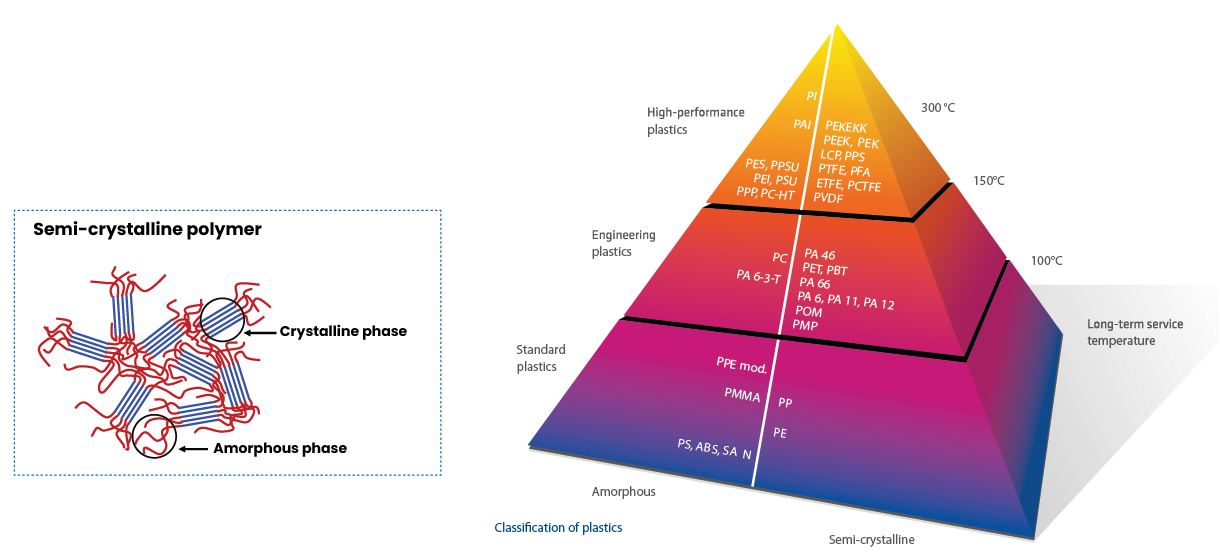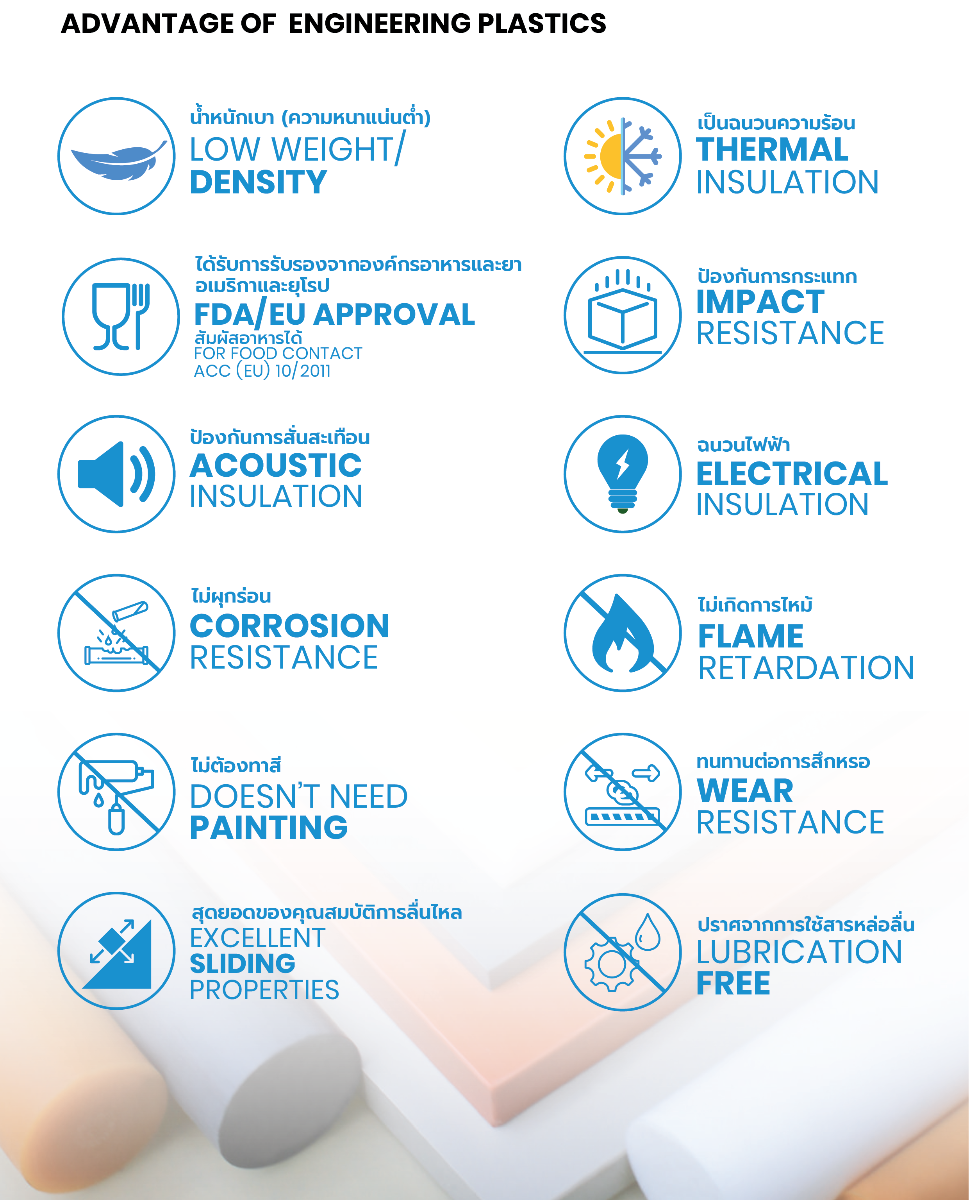Engineering Plastic General Information
ความรู้ทั่วไปเกี่ยวกับพลาสติกวิศวกรรม
General Information about ENGINEERING Plastics

|
Plastics represent polymeric materials that can be processed and molded or shaped to be practical daily-life products. Based on the structure of polymer chains, two main types of plastics can be categorized, i.e., thermoplastics and thermosets. For thermoplastics, the chains of polymers are packed in phases which can be regular ones, namely crystalline phase, and irregular (or random) ones, namely amorphous phase. The uniqueness of thermoplastics is the reprocessability by remolding, simply remelting. The packing between chain polymers depends on the chemical structure and composition of polymers and this leads to the specific mechanical and thermal properties. Pyramid of performances is an overall scheme to categorize thermoplastics based on the relationship between packing structure and thermal stability. For thermosets, the polymer chains are crosslinked to each other leading to high strength and rigidity. Thermosets can be processed by curing (crosslinking) and cannot be reprocessed once their chains are set up in a particular structure. In other words, thermosetting products will be simply degraded if under high temperatures. What is Engineering Plastics?Among thermoplastics, those on the top of Pyramid of Performances are mainly Engineering Plastics. They show excellent mechanical properties (strength, creep resistance, impact resistance, fatigue resistance, and wear resistance) over a wide temperature range The key point to make Engineeering Plastics show high performances is that they are long chain polymers along with (i) the highly crystalline phase and a certain amorphous phase to balance semi-crystalline such as ultrahigh molecular weight PE, (ii) the chemical structure which can be in regular hydrogen bond networks as seen in the case of polyamide (PA) or sometime called nylon, and Kevlar, and (iii) the aromatic component in the main chain which makes the plastic becomes high toughness, for example polyether ether ketone (PEEK). Engineering plastics are suitable for the manufacturing of structural parts and machines where they replace metals in terms of metals, alloys, and composites. In addition, they often also have good chemical resistance and excellent electrical insulation capability. The advantages of engineering plastics in comparison with metals are, - Low density and high specific resistance (resistance/weight ratio) - Chemical resistance - Corrosion resistance - Thermal and electrical insulation - Flexibility of design - Easily moldable - Available in several colors - Reduced total cost of energy
|
|
พลาสติกเป็นวัสดุพอลีเมอร์ที่สามารถแปรรูปทรง ขึ้นรูปเพื่อการใช้งานในรูปแบบผลิตภัณฑ์ต่างๆในชีวิตประจำวัน บนพื้นฐานของโครงสร้างสายโซ่พอลีเมอร์ เราสามารถจำแนกพอลีเมอร์ได้เป็นสองประเภท คือ เทอร์โมพลาสติก และ เทอร์โมเซ็ต สำหรับเทอร์โมพลาสติกสายโซ่พอลีเมอร์จะอยู่ในลักษณะการจัดโครงสร้างทั้งที่เป็นระเบียบ เรียกว่า ส่วนที่เป็นผลึก และ ที่ไม่เป็นระเบียบ เรียกว่า ส่วนที่เป็นอสัณฐาน ความเป็นเอกลักษณ์ของเทอร์โมพลาสติกคือ การขึ้นรูปใหม่โดยการอัดชิ้นงานใหม่ ผ่านกระบวนการหลอมเหลวอีกครั้ง การจัดโครงสร้างนี้ขึ้นอยู่กับโครงสร้างทางเคมีและองค์ประกอบของพอลีเมอร์ ซึ่งสิ่งนี้นำไปสู่สมบัติทางกลและความร้อนของพลาสติกนั้นๆ พีระมิดพลาสติกเป็นภาพรวมที่จำแนกพลาสติกบนความสัมพันธ์ระหว่างการจัดเรียงสายโซ่พอลีเมอร์และความเสถียรทางความร้อน สำหรับเทอร์โมเซต สายโซ่พอลีเมอร์จะอยู่ในรูปการเชื่อมขวางซึ่งนำไปสู่สมบัติด้านความแข็งแรงและความแข็งของวัสดุ เทอร์โมเซตจะถูกขึ้นรูปผ่านกระบวนการเชื่อมขวางและไม่สามารถขึ้นรูปใหม่ได้เมื่อสายโซ่เชื่อมขวางจัดรูปแบบการเรียงตัวเรียบร้อยแล้ว ซึ่งนั่นหมายถึงพลาสติกประเภทนี้จะแตกสลายได้ภายใต้อุณหภูมิสูง พลาสติกวิศวกรรมคืออะไรในบรรดาเทอร์โมพลาสติก ส่วนที่อยู่บนยอดพีระมิดของสมบัติพลาสติกจะเป็นพลาสติกวิศวกรรมโดยหลัก พลาสติกเหล่านี้จะแสดงสมบัติทางกลที่โดดเด่น (ความแข็งแรง การทนต่อแรงดึงยืด แรงกระแทก ทนต่อการค้างอยู่ในสภาพนั้นนานๆ และการใช้งานที่ยาวนาน) ปัจจัยหลักที่ทำให้พลาสติกเหล่านี้เป็นพลาสติกวิศวกรรมที่แสดงสมบัติอย่างโดดเด่นคือ การที่สายโซ่พอลีเมอร์นั้นเป็นสายโซ่ที่มีความยาวสูงพร้อมด้วย (i) มีความเป็นผลึกสูงและมีสมดุลที่ดีกับส่วนที่เป็นอสัณฐาน เช่น พอลีเอทีลีนมวลโมเลกุลสูงยิ่งยวด (ii) โครงสร้างทางเคมีที่มีความเป็นระเบียบของพันธะไฮโดรเจนที่เป็นร่างแห ดังเห็นได้จากกรณีของพอลีเอไมด์ ที่เรียกว่าไนลอน และ เคฟลาร์ และ (iii) องค์ประกอบของวงแหวนอะโรแมติก ที่ทำให้พลาสติกมีความคงทนและเหนียว เช่น พอลีอีเทอร์อีเทอร์คีโตน พลาสติกวิศวกรรมเหมาะสมสำหรับการผลิตเป็นชิ้นส่วนอะไหล่และอุปกรณ์เครื่องจักรเพื่อทดแทนโลหะ อัลลอย และคอมพอสิท นอกจากนี้ พลาสติกวิศวกรรมยังแสดงคุณสมบัติความต้านทานทางเคมีและความสามารถในการเป็นฉนวนไฟฟ้า จุดเด่นของพลาสติกวิศวกรรมเมื่อเปรียบเทียบกับโลหะได้แก่ -ความหนาแน่นต่ำด้วยสมบัติจำเพาะด้านการเป็นฉนวนสูง -ทนต่อสารเคมี -ทนต่อการผุกร่อน -เป็นฉนวนความร้อนและฉนวนไฟฟ้า -ขึ้นรูปง่าย -จัดทำเป็นสีสันต่างๆได้ -ประหยัดพลังงาน |









